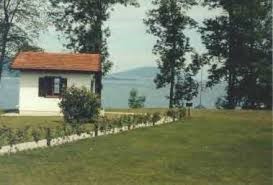who and what, in the midst of the inferno, are not Inferno
Pond-chestnuts poke through floating chickweed on the green brocade pool:
A thousand summer orioles sing as they play among the roses.
I watch the fine rain, alone all day,
While side by side the ducks and drakes bath in their crimson coats.
- Tu Mu (803-852), trans. A.C. Graham
Composing is a solitary activity: one artist, alone in a room, makes something out of nothing. It requires quiet and the right space – within and without. Environment is usually paramount. The composers I know are very seldom found 'writing in restaurants' (the title of a wonderfully frank book on this topic by David Mamet); more often, they have a small, quiet studio set up with a keyboard and a computer – the modern, urban equivalent of the composing houses Gustav Mahler preferred.
Mahler’s composing hut on Attersee Lake in Salzkammergut
I like to think that I, as the conductor, am often the ‘first point of contact’ for a new work after it’s been set down on paper in that private world of the composer. Opening the score for the first time and peering into the composer’s world is a privilege; I often feel that we’re having a kind of silent dialogue over hundreds or thousands of miles, in which I am the receiver. I don’t contribute to this part of the conversation. Yet, it feels like we’re in the room together – their imagination and my ears.
This is also a solitary activity. I have to be alone. It requires quiet. Sometimes I will delay reviewing a new score for days, until I find the right space; I don’t want the intimacy of my introduction to a new creation to have the shadow of some other emotional state over it, or to feel that our first conversation was in haste. When I find that space, I enter one of my ‘favorite places to be,’ in the presence of another artist’s creation, a creation that has been made for our ensemble – this group of singers, gathered at this moment in time. There is always a 'this, for us' moment in which I can hear the singers making the sounds written – sounds often conceived with exactly their colors in mind. And, then comes the gratitude for all the members of the community of art that brought this score to my studio and will bring it to life – the composer, the commission sponsors, the author of the text, the board members and volunteers who believe in our reason for being, the audience members with their insatiable curiosity, my partner and my friends who encourage me to take the time to think up projects or to commune – alone – with a new score, and, of course, the singers and players – the ones who make the music happen.
But that community lies outside my studio, and I wait to introduce it to a new work until I have a grasp on that work, after I feel I’ve answered the big questions.
How has the text been used?
As a narrative?
A program?
A source of imagery or inspiration for musical contexts?
As a source for sounds and colors?
Why?
How is form engaged?
As a means of representing the text?
As a way of engaging the listeners’ memories?
As a solution to a problem?
Why?
In fact, what is the problem or question in need of resolution?
How are the forces engaged?
Are the singers prominent – do they lead – or are they more organically
integrated into a larger texture?
Is it more songlike or more orchestral?
Are there extended techniques (the first step is opening the score is to read the instructions – and, today, there are often many instructions – on vowel transitions, bow techniques, use of microtones, etc.)
Into how many parts do voice sections divide –
and why?
What does it mean?
What does it say?
Why?
Many of these questions are asked and answered simply by getting to know the work – I don’t have a list I check off, but they are there, in the room with me and the imagination of the creator. And, somewhere in there is the occasional afterthought of my own technique – how do I show that in my gesture, in my breath?
When the piece moves into the community, it first reaches the musicians who also will spend some time alone with the new score, figuring out the challenging stuff and then bringing it together to find out how their individuality works in the group – how they will adjust what they bring to make the whole work as a unit. And, eventually, our community opens the doors and the listeners enter. For us, performance is simply that – we open the doors for those interested to join us in the journey. To hear what we’ve discovered. The interesting thing about the role of the listener is that they too will often, in active listening in a concert, find themselves in a very solitary place. Yes, surrounded by hundreds or even thousands of people, but drifting inward, going to a place inside themselves – sometimes they are led there by a very specific programmatic journey of the composer, other times it is because the composer has created a space specifically designed to avoid specificity. But, it’s solitude, nonetheless, and, when it happens, you can feel it in the room – a kind of unconscious return to the studio, and to its quiet, inner life.
Of course, solitude can be crushing. Aloneness can be devastating – something from which we run, terrified, filling the void with vices or television or an overloaded calendar or depression. But, music has the ability to allow solitude to exist and to be felt deeply without fear; while the profound grief of such isolation can be wrenching in a Gustav Mahler or a Samuel Barber or a David Lang or a Prince, it is still, somehow, welcome. And, we are grateful for the courage of the creator and for their solitude. For Anna, David, Lew, Santa, Hans, Pelle, and Caroline.
One of the great literary creators of the 20th century touches on this in the final paragraphs of his masterpiece, Invisible Cities. Here, Italo Calvino (who also wrote a rather famous book about a man who climbed a tree and never came back down) writes not just a summary of the long conversation between Marco Polo and Kublai Kahn, he also writes about himself, where he belongs – or doesn’t. About the role of the artist in the community. About solitude. In the end, it’s about Time and Space and, yes, Love.
He said: ''It is all useless, if the last landing place can only be the infernal city, and it is here that, in ever-narrowing circles, the current is drawing us.''
And Polo said: ''The inferno of the living is not something that will be; if there is one, it is what is already here, the inferno where we live every day, that we form by being together. There are two ways to escape suffering it. The first is easy for many; accept the inferno and become such a part of it that you can no longer see it. The second is risky and demands constant vigilance and apprehension: seek and learn to recognize who and what, in the midst of the inferno, are not inferno, then make them endure, give them space.''
- Italo Calvino, Invisible Cities, trans. William Weaver


